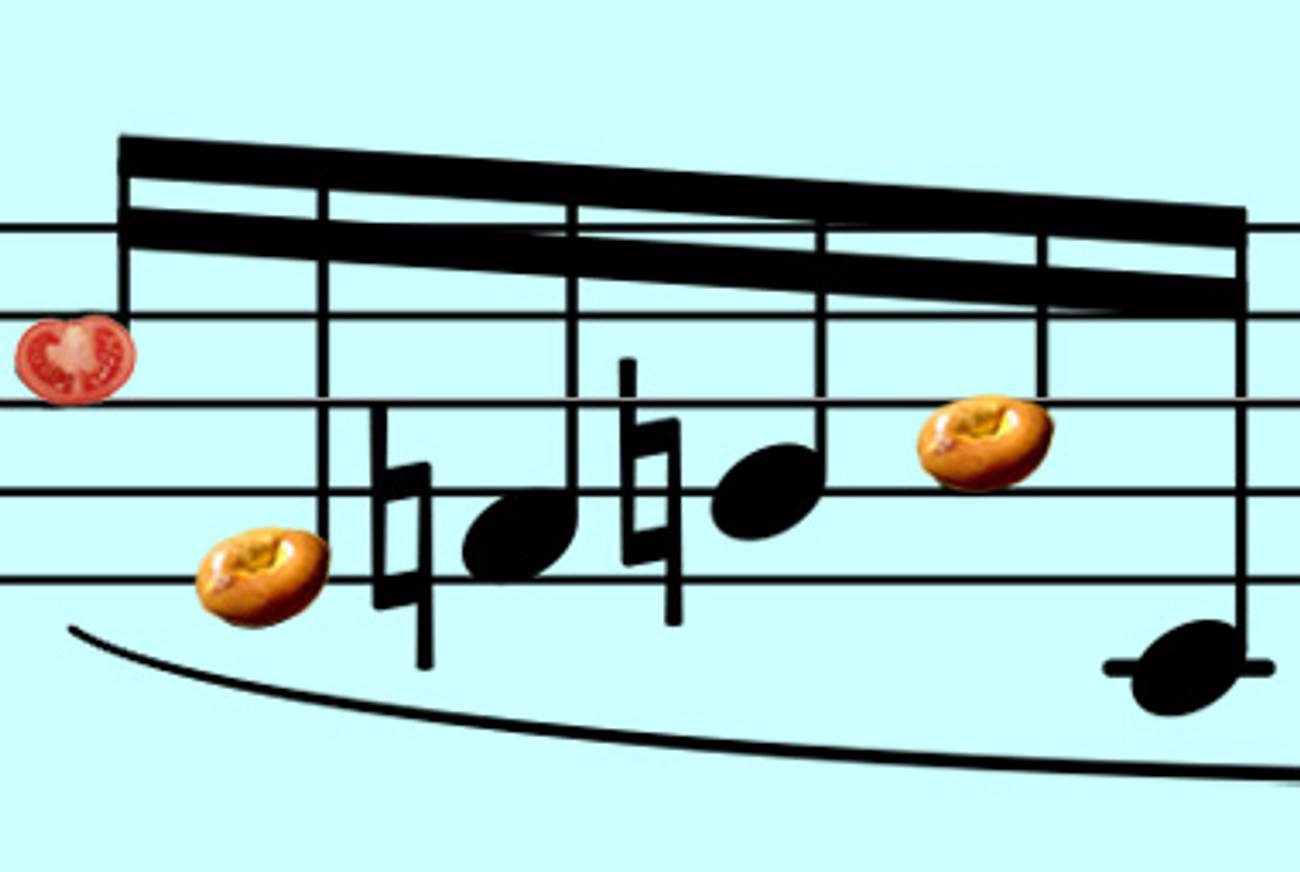Food for Thought
There are more similarities between Jewish music and Jewish food than meets the ear




As a recovering musicologist with a mild and culturally appropriate overeating disorder, I have long appreciated both music and food; even more so in recent years, thanks to saxophonist Paul Shapiro, who features a number of food-themed, Jewish-tinged jazz and R&B tunes (“Dunkin’ Bagel,” “Essen”) in his Ribs and Brisket Revue. But I failed to appreciate just how much Jewish food and music had in common until I attended “Exploring Jewish Cuisine,” a discussion at New York’s 92nd Street Y hosted by the grassroots Jewish organization PresenTense in January.
The session was severely under-attended, especially considering how quickly you’d expect a line of Jews to form for an event about food. Still, the folks who did come had some very interesting—and, for a music critic, strangely familiar—things to say.
“Jewish food is so diverse,” said Russell Moss, the executive chef of 92YTribeca, when asked what makes food Jewish. Brooke Saias, food justice coordinator for the Jewish environmental organization Hazon, discussed food in the context of Jewish geographic dispersal, while Rabbi Ari Weiss, director of the Orthodox social justice movement Uri L’Tzedek, took a more traditional, what’s-Jewish-is-what’s-kosher line. “It’s easier for me to define what isn’t Jewish food than to say what is Jewish food,” he said, singling out the usual suspects for non-inclusion on the Jewish list: lobster and pork.
There was also a lot of talk about sustainable food production, safe working conditions, and other socially conscious subjects. But it was the stuff about definitions and diversity, exclusion and inclusion, that really got my attention. Because everything these people said about Jewish food could just as easily have been said about Jewish music.
Jewish music is also incredibly diverse, the result of thousands of years of forced contact with myriad cultures. As a result, it is just as difficult to define as Jewish food, though you could argue that a failure to agree is an innately Jewish trait that manifests itself over just about any topic. The tendency toward diversity has only accelerated as globalization has made us more aware of the many forms of Jewish music out there, from Bessarabian to Uzbeki; and as shifting attitudes have made us more willing to blend different forms of Jewish music with one another, and with non-Jewish genres.
Many critics and aficionados would probably agree with Weiss’s comment about the relative ease of defining Jewish music by negation—saying what it isn’t (about Jesus), rather than what it is (The 4th Ward Afro-Klezmer Orchestra).
They’d also recognize the admittedly fuzzy distinction between conservatives who favor a close interpretation of historical source material (the European klezmer repertoire, those Ladino songs that were just discovered in a cave in Turkey) and progressives who would rather play with tradition than actually play it. When Saias declared that the new Jewish food movement was about “looking beyond what’s traditionally kosher,” or when Hayley Siegel, a rabbinical student, said that she and Moss tried to plan culinary events with an eye toward “keeping a firm grasp on tradition while moving toward the modern tastes and sensibilities of a young audience,” they might have been describing the contemporary Jewish music scene, which has combined traditional Ashkenazi, Sephardic, and Mizrahi sounds with everything from free jazz to hip hop. “Do we have to eat kreplach and potato kugel?” Moss asked rhetorically. “I don’t think so. There are so many other ways to go.”
There are other, more practical similarities between Jewish music and food. Any Jewish culinary subculture, from the Austro-Hungarian dishes that Moss grew up with to the Byelorussian fare that my grandparents ate, is defined by a list of core ingredients, a clutch of essential recipes, and some basic techniques. Once a cook has those covered, he can personalize his work with strokes both subtle and radical. That’s pretty much how Jewish music works, too; once you’ve mastered the characteristic repertoire and rhythms of a particular genre, its modes and harmonies, its techniques of embellishment and improvisation, then the tradition in question offers not only the comfort of the familiar, but also a vehicle for self-expression. Food for the ears, and for the soul, as well.
Alas, the discussion offered more food for thought than for the belly. Who arranges a talk about Jewish cuisine, then puts out a tray of sliced cucumbers, unsalted pistachio nuts, and Twizzlers? And how can Twizzlers be kosher, when they aren’t even food? When I got home, I booted some online afro-klezmer onto my laptop and stuffed myself with leftover Israeli couscous and not-so-kosher apricot-chicken stew. It’s not something my grandmother would have made—not something she would have listened to, either—but she doesn’t call the shots in my kitchen.
Alexander Gelfand is a recovering ethnomusicologist, a sometime jazz pianist, and a former West African drummer. His work has appeared in the New York Times, the Chicago Tribune, the Forward, and elsewhere.
Alexander Gelfand is a recovering ethnomusicologist, a sometime jazz pianist, and a former West African drummer. His work has appeared in the New York Times, the Chicago Tribune, the Forward, and elsewhere.